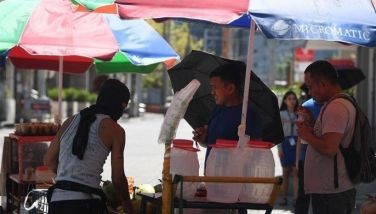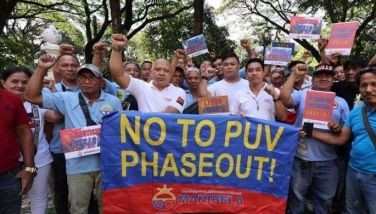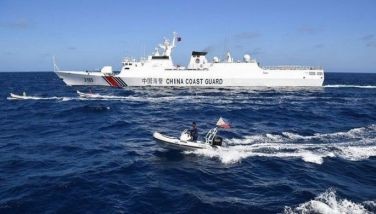‘Extortion worsens port congestion’
MANILA, Philippines - Extortion outside, extortion inside, extortion on the road: corruption is a factor in the congestion in Manila’s ports, according to Cabinet Secretary Rene Almendras.
“After this I can already write a handbook on extortion,” Almendras told a press briefing at Malacañang yesterday, even as he announced that port congestion had been resolved after remedial measures were undertaken and the city government of Manila lifted its truck ban.
Traffic, however, remains heavy around the Manila International Container Terminal and Manila South Harbor as truck haulers wait in long lines while shipment processing continues to crawl.
Almendras, who heads the Cabinet Cluster on Port Congestion, said there was no need to extend the two-week special privilege given to companies and truckers so they could remove their cargo out of the Port of Manila without getting apprehended.
But in the process of decongesting the ports, Almendras admitted there were other problems such as corruption and extortion that must be addressed.
He said the government task force on port congestion found out that some individuals were collecting P500 to P1,500 each from truckers before they were allowed to enter the port.
“It’s very probable that some employees in (the Bureau of) Customs are part of it. So we are going to do something about it,” Almendras said. “There is extortion outside, there is extortion inside, there is extortion on the roads.”
He said the Bureau of Customs (BOC) would issue new guidelines on the processing of cargo to promote transparency.
Apart from ending the port congestion, Almendras said the task force aimed to clean up the system of clearing shipments.
Citing examples of extortion, he said while shipping companies were given allocations for their cargo, some unscrupulous individuals still asked for P500 to facilitate the process.
“Yesterday I found out that sometimes there are even… bidders who pay up to P2,500. You don’t have to pay for that,” Almendras said as he urged victims of extortion to consult a help desk set up by terminal operators.
He gave assurance that other problems would be threshed out with the help of the Department of Trade and Industry.
A meeting with all importers would be called so businessmen can fight abuses and corruption, Almendras said.
“Things are now improving,” he said.
The government is bracing for a surge in shipments starting this month with the holiday season starting and the port still dealing with the backlog.
The ports in Batangas and Subic are now being utilized while additional container yards have been opened in several provinces such as Bulacan and Laguna.
To illustrate the improvement, Almendras told reporters about a car manufacturer that diverted one of its shipments to Subic. The shipment was cleared quickly and reached the manufacturer’s factory in Laguna within seven hours.
He cited the opening of the 24-hour truck lanes and lifting of the Manila truck ban for the improvement.
Almendras claimed the initial traffic jams like the one experienced on the North Luzon Expressway last Sept. 5 could have been caused by other factors.
He said more shipping companies were using the ports in Subic and Batangas.
“It’s not only (the port of) Manila that is congested. Even the port of Hong Kong, even Shanghai and Kaohsiung are all experiencing congestion – not because of us. Even before our congestion happened, they were already congested,” Almendras said.
Gov’t moves to restore yard capacity use
The government is stepping up efforts to bring back yard capacity utilization in the ports of Manila to the normal level of 80 percent after peaking at 110 percent in June due to the truck ban.
The 80 percent means only about 64,800 twenty-foot equivalent units (TEUs) should be inside the ports for optimum terminal efficiency and productivity before the Christmas season.
Almendras said cargo movement to and from the ports jumped by 25 to 30 percent since Sept. 13.
Starting today, a higher storage fee would be imposed on BOC-cleared, ready-to-go containers, from the current P500 per TEU per day after the five-day free storage period to P5,000 after a 10-day free storage period. This is to discourage cargo owners from using the terminals as their virtual warehouses.
Both the International Container Terminal Services Inc. (ICTSI) and Asian Terminals Inc. (ATI) have stepped up efforts to relocate Customs-cleared ready-to-go containers to Subic, Batangas and Cabuyao in Laguna after being slowed down by two typhoons that hit Metro Manila on two consecutive weekends last month.
“We continue to appeal to the public to remain considerate as we are already going full-blast in our efforts to decongest the ports. We guarantee that the benefits after decongesting our ports will outweigh all the inconveniences they encounter if we have a congested port,” Almendras said.
For his part, Transportation Secretary Joseph Emilio Abaya said the government is looking at developing more ports outside Manila, including one in Sangley, Cavite, and expanding the ports of Subic and Batangas.
He said the government is addressing the possibility of congestion in ports outside Manila such as in Cebu and Davao. – With Lawrence Agcaoili, Evelyn Macairan
- Latest
- Trending






























